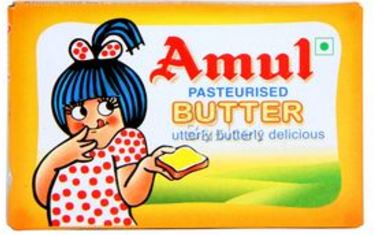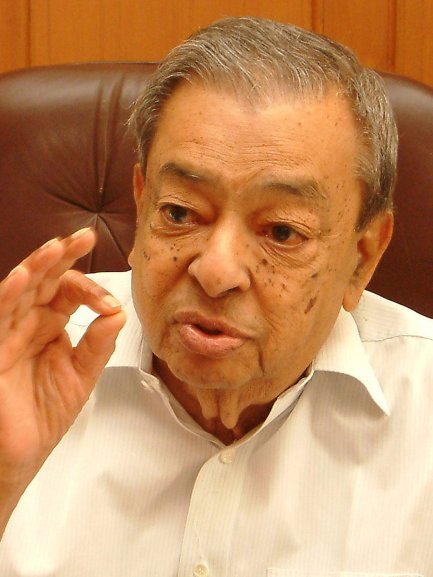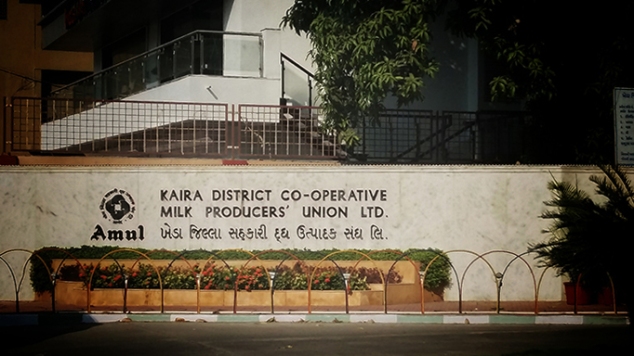This week, I am delighted to welcome back Rajiv Chopra, who is introducing his fourth trailblazer nominee: Dr. Verghese Kurien. Rajiv is a very talented writer and photographer who is writing about several Indian trailblazers to open our eyes to Indian culture, its history, and its people.
The Legend of Dr. Kurien
The principle of milk collection was founded on the practice of first come-first served. Your caste, creed, religion or wealth did not matter. ~Dr. Kurien

When I was a young manager in the corporate world, Dr. Verghese Kurien was something of a legend and a hero. The dominant brand in the dairy business in those days, and even now is called Amul, marketed by the Gujarat Cooperative Milk Marketing Federation, or GCMMF. However, everyone simply calls it ‘Amul’.
Amul butter was often in short supply, and I was one of those lucky people who knew a distributor of the Amul dairy products. As soon as I would get wind of the supply reaching his warehouse, I would dash off, and buy five or six packs of butter and cheese.
Today, the situation is different. India is the world’s largest producer of milk and produces, according to some estimates, 18% of the world’s milk supply.
It is worthwhile to ponder the statistics. In 1950-51, the Indian population was 359 million, and we produced 17 million tons of milk. This is 0.04 tons per person per year. In 2012-13, with a population of 1.212 billion, we produce 132.4 million tons per year, or 0.11 tons per person per year. So, despite the four-fold increase in India’s population, the per capita production of milk has tripled. This is an astounding achievement in a country like ours.
What is even more astounding is the fact that the country has achieved this while giving money back to the farmers, and the milk cooperatives have followed their principles.
I have visited Anand, the town where it all began, and I have visited the milk factory of the Kaira Co-operative. The last time I was there, I took a few gents from Turkey to see the place. They had gone on the tour with the idea of teaching “Amul” a few things about dairy logistics. But after they saw the film of the story of the cooperatives, they had tears in their eyes, and asked if they could stay longer to learn, instead of to teach.
You may ask a few questions: where does Dr. Kurien fit into all of this? Was he a visionary or an implementer?
Either way, when you read the story, the real question to ask is: how did one man achieve so much in one lifetime, and how did he do so much to benefit so many people?
A Reluctant Engineer
Dr. Verghese Kurien did not intend to become a dairy engineer. He wanted to study metallurgy or nuclear science. I will not get into his early life, birth and education, save to say that he studied metallurgical engineering and nuclear science, and that he was granted a scholarship to study dairy engineering. As per his autobiography, he went to the U.S. to study dairy engineering, but actually studied metallurgy and nuclear physics.

Source:https://en.wikipedia.org/wiki/Verghese Kurien
On his return, he was asked to see the Under Secretary of Education, and was told that he had been assigned to report to a place called Anand, which Dr. Kurien had never heard of. It was destined to be his home for the rest of his life.
His first home in Anand was an abandoned garage. A bathroom was built out of three corrugated sheets. But here, he began his professional life. This was 1949, and the milk cooperative at Kaira was struggling to survive.
Little did Kurien know that this challenge would define his entire professional life.
The Battle Over Milk Marketing
Kurien was reluctantly thrust into the battles of a fledgling country that was struggling to stand on its feet.
In the late 19th and early 20th century, the milk industry, like India itself, was under the control of Europeans. About 1895, an English gentleman started a milk factory in a place 15 km from Anand. A German set up a casein factory, and in 1926 an uneducated Parsi gentleman called Pestonjee started a milk factory, and he marketed the products under the Western sounding name, “Polson”. By 1942-43, he had quite dominated the market. Demand had increased, and to meet this, the farmers upped their production. When demand came from Bombay, 350 km away, he pasterurized the milk. To meet the demand, he asked for and received grants from the British Government.
In addition, he asked for, and got permission to be the exclusive milk collection agent in the district. Soon enough, prices were raised, but only a fraction of this went to the farmers.
In the years leading up to India’s independence, farmers complained to Sardar Vallabbhai Patel, who suggested that they organise themselves into cooperatives. He asked Morarji Desai to coordinate this. When India gained its independence, Sardar Valabbhai became the Deputy Prime Minister of India, and many years later, Morarji Desai became Prime Minister as well.
They appointed a young freedom fighter called Tribhuvandas Patel to be chairman of the co-operatives, and this is where the story of the Kaira Milk Co-operative began. This was the seed that was to flower into GCMMF, the brand Amul, the National Dairy Development Board and co-operatives in many states of India.
The Early Years of the Amul Brand
Initially, Dr. Kurien was not enthused about his role, and was quite inclined to leave. Tribhuvandas Patel induced him to stay, and gradually, he became more and more used to the idea of staying.
They fought off a challenge from Pestonjee’s Dairy, and innovations started to flow. He experimented with and succeeded in making milk powder from buffalo’s milk, something that experts had told him was impossible.
The GCMMF, which was set up in 1946, is the federation that markets the milk on behalf of the producing co-operatives. What Kurien realized is this: while much discussion among farmers often centred around milk production, cow productivity, and so on, what was really vital for the farmers was to ensure a steady market for the products that were produced by the dairies. So, one area that he turned his attention to was marketing.
The Kaira Co-Operative developed and registered the brand name “Amul” in 1957, and this was the first step into the journey of branded goods. “Amul” is an acronym of Anand Milk Union Limited. It is also a shortened form of the word, “Amulya”, which means priceless. Over the years, it has indeed become a brand that is priceless. It is a brand that has been woven into the fabric of modern Indian consciousness.
Along the way, they conceived of one of the most enduring brand symbols in India – the Amul girl, along with their tag line–‘utterly, butterly delicious’.
The Experiment Becomes a Success
In 1964, the Prime Minister of India Lal Bahadur Shastri visited Anand to inspect the facilities, and to see for himself if the Kaira experiment was a true success. To this end, he spent the night in a village in the area and the next day he confirmed that it was a success. After the visit, he then met Dr. Kurien, and asked him to set up similar co-operatives across India.

The Kaira Cooperative. Photo: Rajiv Chopra.
Initially when the National Dairy Development Board (NDDB) was set up in Anand it had no office space. Gradually, it built up over the years, and today anchors the development of the co-operatives, as well as scientific improvements in cattle breeding across the country.
The NDDB was also established as a society under the Societies Registration Act of 1860. This was also the year in which Operation Flood was conceived. The plan, or ambition, was to make India a country that produces one million litres of milk per year. When I visited NDDB in November 2015, I was taken through their heritage wall, and they spoke to me of the plan to continue to make India milk sufficient through the year 2020.
There is pride in the people of GCMMF, and there is pride in the people of the NDDB. They realise what has been achieved, and what yet needs to be done.
Dr. Kurien’s Impact
India’s place in the sun would come from the partnership between the wisdom of its rural people and the skill of its professionals.
The system that Kurien set up is, at heart, a three-tier system. The primary level is at the village level. The next is the district level, and the third is the state level. Milk is collected twice a day at milk collection points, from where it is sent to chilling plants, and then to the factories.
Over time, Dr. Kurien realised that, for the dairies to be developed they also needed managers who understood rural marketing. Most students from traditional management institutes are comfortable with urban-centric or multi-national organisations. To build a corps of managers who understood the nuances of the rural markets, Dr. Kurien set up the Institute of Rural Management Anand (IRMA) in Anand, in 1979, which is still a key source of knowledge on rural marketing in India.
GCMMF serves 3.6 million milk producers in Gujarat. NDDB serves 70,000 cooperatives and 8.4 million farmers across India.
The question that may be asked is: was Dr Kurien a true visionary, or did he merely implement the vision of Sardar Vallabhai Patel, Tribhuvandas Patel and Lal Bahadur Shastri?
It is to his credit that he could take their basic vision, imbue it with his own, and develop it into a massive developmental exercise, the like of which has rarely been seen. It is to his credit that, in the expansion of the milk co-operatives and the business, he remained true to the founding principles that were laid down at the inception, and did not waver, despite attempts by politicians to interfere. He was known for his humility, his dedication, his passion. He was also known for his plain speaking, and his no-nonsense attitude.
That he could take India from being a milk deficient country to the largest milk producer in the world is no mean achievement, and is a testament to the man.
In 1965, Dr Kurien was given an honorary doctorate by Michigan State University. He also received other honors both in India and overseas before his death on the 9th September, 2012. His own words are a fitting summation of his life work: “The development is not of the land or of cows; it is the development of men and women.”
To read more about Dr. Kurien, click on the links below:
- drkurien.com
- amuldairy.com
- nddb.org
- www.fao.org
- www.indiadairy.com
- Autobiography I Too Had A Dream”, Dr Verghese Kurien, as related to Gouri Salvi on Amazon.com
- Amul Commerical 2011: http://youtu.be/4SiRZNx4jlE
This is the fourteenth in a series of articles about forward thinkers who are helping to solve some of the world’s greatest challenges. These remarkable people are helping to define the future direction of their community, country, and even our global society. To read more about the Pilot Fish Trailblazer Awards and the nominees Dr. Fred Sanger, Paolo Soleri, Ruth Bader Ginsburg, Jane Goodall, Alice Waters, Swami Vivekananda, The Man in Black, Dr. B. R. Ambedkar, Dr. Jean Raffa, Astrid Lindgren, Sadar Vallabhbhai Patel, Cleveland Amory, and Dr. Seuss click on the embedded links. Suggest new nominees in the comments section below.
Categories: Pilot Fish Trailblazer Awards
Thanks for the introduction.
LikeLiked by 1 person
I think Rajiv made a good choice, don’t you? I’m learning so much about Indian history.
LikeLiked by 1 person
Yes…
LikeLiked by 1 person
I had no idea about any of this. Some of the most creative and brilliant minds end up down paths they never dreamed–and that enrichens the lives of so many.
LikeLiked by 1 person
Very true, Luanne. Sometimes we end up in career paths we never expected. I have had a number of careers. Have you? I think each one leads to the next.
LikeLiked by 1 person
I have worked in both business and academic worlds, so, yes, although I think there is some consistency to what I have done. Maybe more so than many people.
LikeLiked by 1 person
Reblogged this on Rajiv Chopra and commented:
For those who don’t know Dr Kurien, he was a remarkable man indeed
LikeLiked by 1 person
Sometimes the people with the greatest impact are the ones who tackle problems which appear to be simple but have national and international consequences. Thanks for a great post, Rajiv.
LikeLike
i am a great fan of Dr Kurien and a complete brand loyalist,when it comes to AMUL:)
LikeLiked by 1 person
So glad you agree with Rajiv’s choice! Thanks for joining the conversation.
LikeLike
What a fascinating life Patti! You choose the most fascinating people!
LikeLiked by 1 person
Thanks, Maria, but Dr. Kurien was Rajiv’s pick. He always surprises me! 🙂
LikeLike
A real success story, especially when compared to UK where the amount that farmers receive for milk is criminally tiny, due to the big supermarkets holding all of the power. I hope that never happens in India!
LikeLiked by 1 person
Hi Mick. It is different here in the U.S. too. I love how Rajiv highlighted a man who revolutionized milk production–something that is easily overlooked as a less significant. But what is more significant than providing sustenance!
LikeLiked by 1 person
Definitely. Highly significant.
LikeLike
Great post, there’s so much to learn about India. Interesting to know how they developed the dairy industry.
Leslie
LikeLiked by 1 person
Hi, Swo8. Thanks for your thoughts on Dr. Kurien and learning more about India. I am always surprised about how much there is to learn. 🙂
LikeLiked by 1 person
India has a wealth of history. The more recent part with Dr. Kurien is interesting because we can reflect on the development of our own dairy industry in Canada.
Leslie
LikeLike